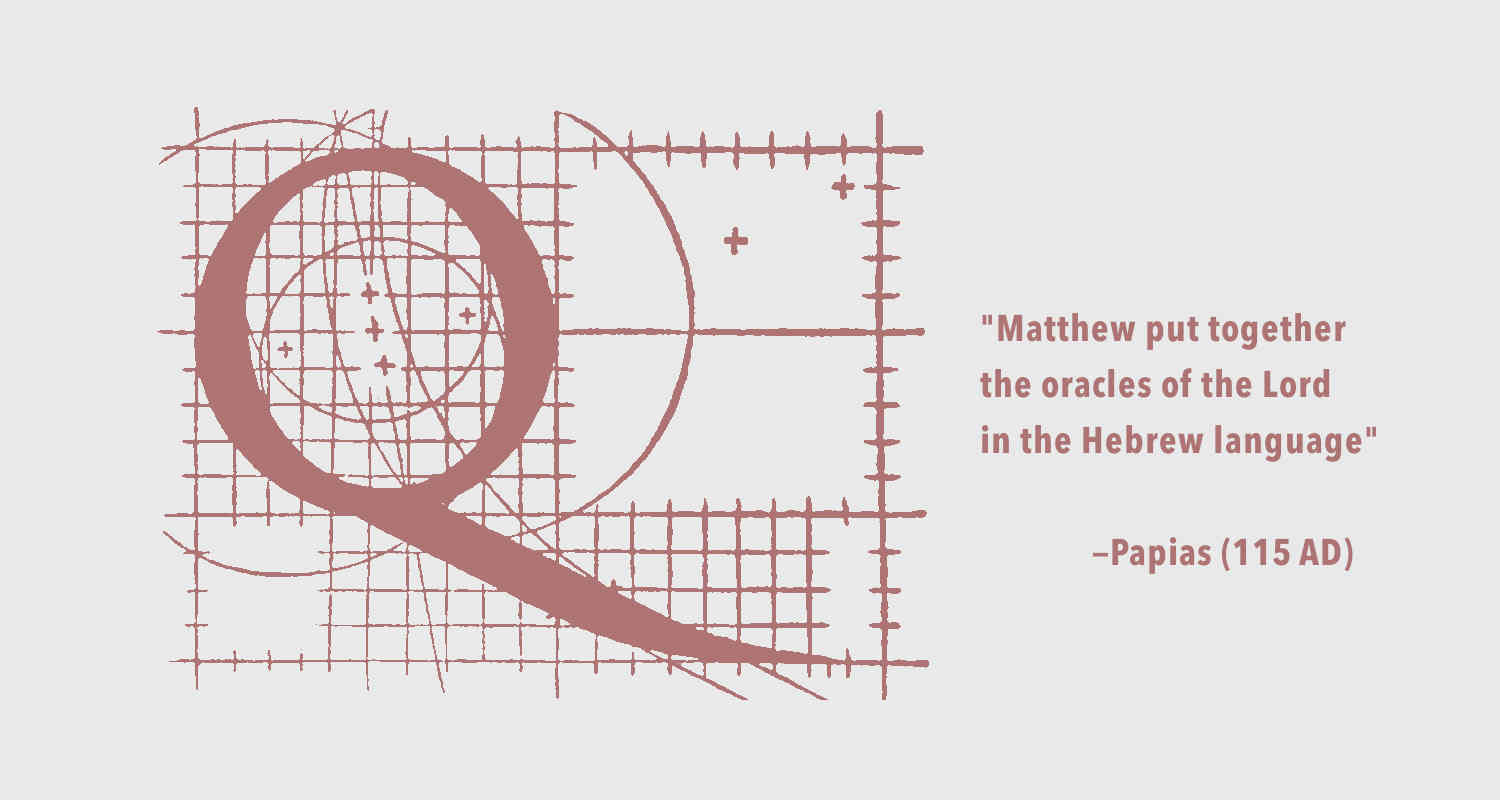
What is Q?
Q Document (or Q) refers to a common source used by the gospels of Matthew and Luke independently, and may be reconstructed by the agreements between the Greek sources of Matthew and Luke. ("Q" coined by J. Weiss in 1880 and Q is an abbreviation for the German word Quelle meaning 'source' ). [1] There are 220-235 verses [2] that are in both Matthew and Luke and often these verses are identical word-for word. Matthew and Luke mutually revise, expand and omit text from the Q sources in the same way that they incorporated cited Mark. Q consists primarily of sayings (or oracles / logia), so Matthew and Luke are more likely to preserve its sources than the narratives of the gospel of Mark.
Q's original form has been lost in transmission but Q has been preserved through its encapsulation within Luke and Matthew. In the same way that Mark may not be reconstructed exactly from Matthew and Luke, Q's original form will never be known and remains hypothetical until a long lost copy of it is discovered in the sands of Egypt (like the Dead Sea Scrolls). So I agree with J. P. Meier's famous conclusion that "Q is a hypothetical document whose exact extension, wording, originating community, strata, and stages of composition cannot be known." However, when Q is encountered within Luke and Matthew, then special attention is required because of the Q verse represent the oldest attestations to Jesus in the Synoptic Gospels (and arguably the whole NT). Often the Gospel of Mark is given preeminence because it is the earliest gospel, but Q is often argued to be older than Mark! There are good reasons to believe that Luke and Matthew possessed similar copies of a Greek translation of Q (based on a common older Aramaic source). Whenever Q is encountered in Luke or Matthew, then it must be consulted with special significance as the most primitive witness to the words of Jesus, as a first among equals in the New Testament canon (like Mark or Paul's earliest letters or James).
Discovery of Q
In Friedrich Schleiermacher's The Life of Jesus (1832), he conjectured that there was a lost sayings source behind the extent gospels based upon Papias' statement in 115 CE, "Matthew put together the oracles (λόγια) of the Lord in the Hebrew language (Ἑβραΐδι διαλέκτῳ)". Little did he know, Schleiermacher was among the first theologians to discover the existence of the Q document. Papias is an extremely early witness to the existence of a sayings (i.e. logia) of Jesus document that was written in Aramaic (i.e. Hebrew dialect) that was used by Matthew (and Luke).
Papias, the Bishop of Hierapolis, was despised by Eusebius who called him "a man of small mental capacity" in order to suppress him, was initially vindicated by Schleiermacher (and other 19th century theologians), and it is sad that only fragments of Papias' early witness have been transmitted to this day.
Here is a full quotation of the important quote from Papias:
"And the presbyter [John] would say this: Mark, who had indeed been Peter's interpreter, accurately wrote as much as he remembered, yet not in order, about that which was either said or did by the Lord. For he neither heard the Lord nor followed him, but later, as I said, Peter, who would make the teachings anecdotally but not exactly an arrangement of the Lord's reports, so that Mark did not fail by writing certain things as he recalled. For he had one purpose, not to omit what he heard or falsify them. Now this is reported by Papias about Mark, but about Matthew this was said, Now Matthew compiled the reports in a Hebrew manner of speech, but each interpreted them as he could." —Papias [3]
Schleiermacher, Papias, and the existence of Q was vindicated by B. H. Streeter's Two-Source Hypothesis solution to the Synoptic Problem (that overthrew the long standing Augustine Hypothesis). The Two-Source Hypothesis caused Mark and Q to overthrew Matthew as the oldest sources to the historical Jesus. Furthermore, the discovery of the Gospel of Thomas in Nag Hammadi in 1945 demonstrated that sayings sources (logia) existed in the earliest stratum of Church History (further validating Q, Papias, and Schleiermacher, etc).
Significance of Q
The exciting possibility of reconstructing the Q source yields the possibility of possessing an early Christian witness to Jesus Christ that precedes all of the extent New Testament writings. Q also allows highlighting 200+ verses in Matthew and Luke that are as old as the gospel of Mark (or are likely older than Mark), indicating those highlighted verses are equally primitive to the extent gospel of Mark. Also, Papias' witness to an Aramaic original source of Q justifies the fruitful reconstruction of Aramaic original versions of the Greek logia in Q through textual and form criticism (c.f. Joachim Jeremias' New Testament Theology.)
Q is also may be used as a control for discovery of theological development within the New Testament. By comparing later New Testament writings, we may understand early Jewish Christianity via Q's low Christology, and its limited use of parables and apocalyptic writings. I recommend skimming the following table containing R. E. Brown's reconstruction of Q and consider his summary of Q for a fruitful discussion.
The existence of Q validates the early witness of the New Testament writings. In addition to Paul's letter and the gospel of Mark, we also possess Q (in its encapsulated form with Luke and Matthew) that demonstrates the Christian scriptures a true human witnesses to the very words of Jesus Christ at the earliest stratum of the Church.
Reconstruction of Q by R. E. Brown
The Q source has been reconstructed in detail, and there are many excellent books available that may be purchased to study Q in depth. In Raymond E. Brown's An Introduction to the New Testament, he provides a table that is an excellent summary of Q that includes the parallel scripture references between Matthew and Luke:
| Matthew | Luke | Contents |
|---|---|---|
| Mt 3:7b-12 | Lk 3:7-9,16-17 | JBap; warnings, promise of one to come |
| Mt 4:2b-11a | Lk 4:2-13 | three temptations (testings) of Jesus by the devil (different order) |
| Mt 5:3,6,4,11-12 | Lk 6:20b-23 | beatitudes (different order, wording) |
| Mt 5:44,39b-40,42 | Lk 6:27-30 | love of enemies; turn other cheek; give coat; give to beggars |
| Mt 7:12 | Lk 6:31 | what you wish others to do to you, do to them |
| Mt 5:46-47,45,48 | Lk 6:32-33,35b-36 | love more than those who love you; be merciful as the Father is |
| Mt 7:1-2 | Lk 6:37a,38c | judge not and be not judged; measure given is measure received |
| Mt 15:14,10:24-25a | Lk 6:39-40 | can blind lead the blind; disciple not above the teacher |
| Mt 7:3-5 | Lk 6:41-42 | speck in brother's eye, log in one's own |
| Mt 7:16-20 (12:33-35) | Lk 6:43-45 | no good tree bears bad fruit; no figs from thorns |
| Mt 7:21,24-27 | Lk 6:46-49 | calling me Lord and not doing; hearing my words and doing them |
| Mt 8:5a-10,13 | Lk 7:1-2,6b-10 | centurion at Capernaum begs help for sick servant, marvelous faith |
| Mt 11:2-11 | Lk 7:18-28 | disciples of JBap; message to him; praise of JBap as more than a prophet |
| Mt 11:16-19 | Lk 7:31-35 | this generation pleased by neither Man nor Son of Man |
| Mt 8:19-22 | Lk 9:57-60 | Son of Man has nowhere to lay head; to follow him let dead bury dead |
| Mt 9:37-38; 10:7-16 | Lk 10:2-12 | harvest plentiful, laborers few, mission instructions |
| Mt 11:21-23; 10:40 | Lk 10:13-16 | woe to Chorazin, Bethsaida; whoever hears you, hears me |
| Mt 11:25-27; 13:16-17 | Lk 10:21-24 | thanking the Father for revealing to infants; all things given to the Son who alone knows the Father; blessed eyes that see what you see |
| Mt 6:9-13 | Lk 11:2-4 | the Lord's prayer (variant forms-Matthew's longer) |
| Mt 7:7-11 | Lk 11:9-13 | ask and it will be given; if you give good gifts, how much more the Father |
| Mt 12:22-30 | Lk 11:14-15,17- 23 | demons cast out by Beelzebul; strong man guards his palace; not with me, against me |
| Mt 12:43-45 | Lk 11:24-26 | unclean spirit gone out of someone returns and brings seven others, making worse |
| Mt 12:38-42 | Lk 11:29-32 | generation seeks sign; sign of Jonah; judgment by people of Nineveh, queen of south |
| Mt 5:15; 6:22-23 | Lk 11:33-35 | not putting lamp under bushel; eye lamp of body, if unsound darkness |
| Mt 23:25-26,23,6-7a,27 | Lk 11:39-44 | Pharisees cleanse outside of cup; woe for tithing inconsequentials, seeking first place |
| Mt 23:4,29-31 | Lk 11:46-48 | woe to lawyers for binding heavy burdens, budding tombs of the prophets |
| Mt 23:34-36,13 | Lk 11:49-52 | I speak/God's wisdom speaks: Will send prophets who will be persecuted; woe to lawyers |
| Mt 10:26-33; 12:32 | Lk 12:2-10 | all covered to be revealed; fear not killers of body; acknowledging me before God |
| Mt 10:19-20 | Lk 12:11-12 | before synagogues, Holy Spirit will help |
| Mt 6:25-33 | Lk 12:22-31 | don't be anxious about the body; consider lilies of field; Father knows what you need |
| Mt 6:19-21 | Lk 12:33-34 | no treasures on earth but in heaven |
| Mt 24:43-44,45-51 | Lk 12:39- 40,42-46 | householder and thief; faithful servant preparing for master's coming |
| Mt 10:34-36 | Lk 12:51-53 | not come to bring peace but sword; divisions of family |
| Mt 16:2-3 | Lk 12:54-56 | ability to interpret weather signs should enable to interpret present times |
| Mt 5:25-26 | Lk 12:58-59 | settling before going before the magistrate |
| Mt 13:31-33 | Lk 13:18-21 | kingdom of heaven/God: like growth of mustard seed; like leaven woman puts in meal |
| Mt 7:13-14,22-23; 8:11-12 | Lk 13:23-29 | narrow gate through which few will enter, householder refusing those who knock; people coming from all directions to enter kingdom of heaven/God |
| Mt 23:37-39 | Lk 13:34-- 35 | Jerusalem, killing the prophets, must bless him who comes in the Lord's name |
| Mt 22:2-10 | Lk 14:16-24 | kingdom of heaven/God: a great banquet, invitees make excuses, others invited |
| Mt 10:37-38 | Lk 14:26-27 | anyone coming must prefer me over family and must bear a cross |
| Mt 5:13 | Lk 14:34-35 | uselessness of salt that has lost its savor |
| Mt 18:12-14 | Lk 15:4-7 | man who leaves 99 sheep to go after lost one |
| Mt 6:24 | Lk 16:13 | cannot serve two masters |
| Mt 11: 12-13; 5:18,32 | Lk 16:16-18 | law and prophets till JBap; not a dot of Law will pass; divorcing wife and marrying another is adultery |
| Mt 19:7,15,21-22 | Lk 17:1,3b-4 | woe to tempters; forgive brother after rebuking; Peter: how often to forgive |
| Mt 17:20 | Lk 17:6 | if you had faith like grain of mustard seed, could move mountains |
| Mt 24:26-28 | Lk 17:23-24,37 | signs of the coming of the Son of Man |
| Mt 24:37-39 | Lk 17:26-27,30 | as in the days of Noah, so will be the coming of the Son of Man |
| Mt 10:39 | Lk 17:33 | whoever finds one's life will lose it; whoever loses will find it |
| Mt 24:40-41 | Lk 17:34-35 | on that night of two, one taken and the other left |
| Mt 25:14-30 | Lk 1:12-27 | parable of the pounds/talents |
| Mt 19:28 | Lk 22:38,30 | followers will sit on thrones judging the twelve tribes of Israel |
Source:
1. Raymond E. Brown, An Introduction to the New Testament, footnote in https://postbarthian.com/wp-content/uploads/2012/05/brown_syn1.pdf
2. Brown. Ibid.
3. http://www.hypotyposeis.org/synoptic-problem/2004/10/external-evidence-papias.html [EH 3.39.16]
4. Raymond E. Brown, "Table 2. Material Usually Allotted to Q", An Introduction to the New Testament, pg 118-119
5. Header image contains image of 'Q' from wikipedia



May 24th, 2019 - 17:14
Yes. I have been intrigued by the possibility that Mark is the first gospel, Matthew the second, using Mark and his sources, and Luke used Mark and Matthew. The Old Testament parallel would be the re-write of Samuel and Kings that we find in Chronicles. Mark Goodacre has done some work on this. I have been testing it as I move through the lectionary texts this year on Luke. So far, though, the speculation involved in hypothesizing the existence of Q makes more sense.